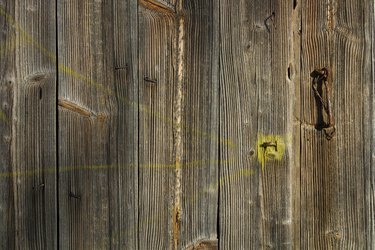Things You\’ll Need
-
Protective eye wear
-
Wire brush
-
Lye based oven cleaner
-
Vinegar
-
Soft cloth
-
Tea
-
Sandpaper
-
Burlap sheet
-
Heavy metal chain
-
Propane torch
 Now you can artificially age and weather wood.
Now you can artificially age and weather wood.
Making wood look weathered and worn before its time is easy with the use of some commonly found household chemicals. New wood is often too bright and clean for many applications, renovations and installations, but you can weather it prematurely to match any specific need. By following these easy steps, you can adjust the appearance of your wood to suit the needs you have for it. Either use a combination of these steps or just one or two until you have achieved the amount of weathering you seek.
Video of the Day
Step 1
Rub down your selected piece of wood using a wire brush. Rub the wood with the grain with a coarse wire brush in to roughen the wood fibers and make it more susceptible to the following treatments.
Step 2
Spray your piece of wood with a lye-based oven cleaner. Lye is caustic and will eat away at the fibers in the wood, making the wood look aged and weathered before its time. Keep an eye on the piece of wood sprayed with lye as it will change and age in appearance quickly.
Step 3
Soak a soft cloth in vinegar and then rub the wood down with it to neutralize the lye when the desired amount of wear has been attained in your piece of wood. Repeat the lye application if desired.
Step 4
Soak a soft cloth in a strong tea or coffee solution and rub it into the wood to transfer the brown tones of the tea or coffee to the wood.
Step 5
Wrap your piece of wood in a burlap fabric sheet. Strike the wood with the burlap over top with a heavy metal chain or other like object to dent and damage the surface of the wood to give it a worn appearance. Hitting the piece of wood along the edges will cause small cracks to form, which will resemble worn and weathered wood.
Step 6
Light the tip of a propane torch or other source of flame/heat and apply heat along the grain lines in your piece of wood to give it a worn look. Burn the edges followed by sanding to create low areas or areas of damage on the wood.
Warning
Always wear eye protection when working with lye. Use vinegar to neutralize any lye spills.


